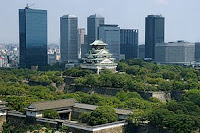
In the old days, Osaka is known as Naniwa has become a gateway to international trade since around the 5th century. Naniwazu Harbor is the entrance into Japan's ancient tumulus period (709 AD) when trading with China and the Korean peninsula reached its peak. From Naniwazu into ceramics manufacturing technology, carpentry, and Buddhism which was brought in from China and Korea.
As a port city, Naniwazu role is as a transport hub. From a large warehouse located in Naniwazu, merchandise is transported through the Yodo River toward the capital at that time was in Nara and then moved to Kyoto.
Although it does not last long, Osaka was once the ancient Japanese capital in the age of Naniwa (mid-7th century until the mid-eighth century). Naniwa Palace of Emperor Nintoku building and named the town where his palace as Naniwa no miya (Capital of Naniwa). Naniwa glory can be proved with broad measure of the tomb of Emperor Nintoku in the city of Sakai.
The chaos caused by continuous wars that began in the late Kamakura period until the time of the Palace of the North and South brought the destruction of Naniwa. In 1532, Buddhist monks named Rennyo establish Ishiyama Honganji temple in a suitable location with the soil condition is called Osaka (大 坂; big climbs). Residents began to settle in locations around the temple which is the embryo of a city which became known by the name of Osaka.
In 1583, Toyotomi Hideyoshi succeeded in becoming the unifier of Japan and build a castle that is named Osaka Castle in Osaka Honganji temple ruins location. Settlement residents around Osaka Castle eventually evolved into the economic and governmental center of the city called Osaka.
After the death of Toyotomi Hideyoshi and the fall of Osaka Castle, the shogun Tokugawa Ieyasu moved to Edo Japanese government center. Called Edo Shogunate government to rebuild the palace and the city of Osaka.
In the Edo period, Osaka was built storage areas, canals, and bridges that accelerate trade. At that time, Osaka is known as "Kitchen Interior" (Tenka no Daidokoro) because Osaka is a food distribution center for all of Japan. The price of rice for the whole of Japan was set based on the price of rice Dojima Rice Market in Osaka.
Government Shogunate Edo sent police Shogunate city of Osaka (Osaka-cho Bugyo) to divide the settlement of population based on its location: Pillars of the North (Kita-gumi), Pillars of the South (Minami-gumi), and the Five Pillars of Temma (Temma-gumi). Pillars Pillars of North and South are in the Chuo district now called me while Pillars Tenmangu around Osaka Temmangu Shrine temples in the district of Kita-me. At that time, Osaka is called by the name of Osaka san-go (three districts Osaka) because of a combination of the three pillars of the population.
After the Meiji Restoration (1868) is completed, the Meiji government formed consisting of Osaka Prefecture, Osaka city and san-go area around him. Name the city also restored, to Osaka (大阪) without the suffix "san-go," and replacing kanji for the word "saka" used to write the word of Osaka. Under the zoning regulations Gun me-cho-son, the city of Osaka and then divided into four districts: Kita-ku, Higashi-ku, Nishi-ku, and Minami-ku.




















-image1362371%5B2%5D.jpg)





